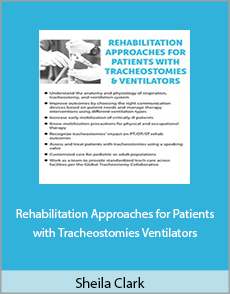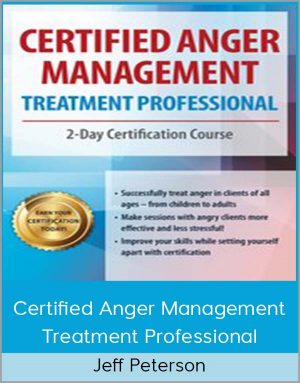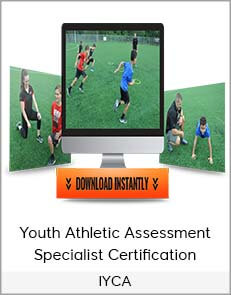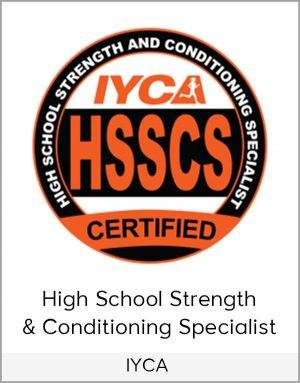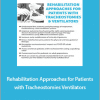Sheila Clark – Rehabilitation Approaches for Patients with Tracheostomies Ventilators
$45.00$219.99 (-80%)
While working on compensatory strategies, functional mobility, and ADLs in therapy, they’re also developing communication skills, learning swallowing techniques, and adjusting to medical equipment.
Sheila Clark – Rehabilitation Approaches for Patients with Tracheostomies Ventilators
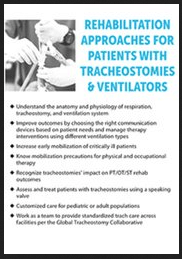
Check it out: Sheila Clark – Rehabilitation Approaches for Patients with Tracheostomies Ventilators
Description
Trachesostomy and ventilator patients face a number of added challenges that often impact therapy outcomes. While working on compensatory strategies, functional mobility, and ADLs in therapy, they’re also developing communication skills, learning swallowing techniques, and adjusting to medical equipment.
This recording explores the latest solutions to these and other challenges of tracheostomy and ventilator management. Examine current tracheostomy benefits, considerations, and best practices by reviewing the anatomy and physiology of respiration, as well as the many different types and combinations of tracheostomy tubes, speaking valves, and ventilators. Discuss how tracheostomies and ventilators impact physical, occupational, and speech therapies, and take home evidence-based tools and rehab strategies the whole team can use to improve rehab outcomes with pediatric and adult populations.
Handouts
Outline
NEUROANATOMY AND PHYSIOLOGY OF RESPIRATION
- Definitions and terminology
- Diseases of the respiratory system
TYPES OF VENTILATION
- Invasive
- Noninvasive
- Goals and differences from natural respiration
- Sutt articles
TRACHEOSTOMY CONSIDERATIONS
- Purpose
- Percutaneous vs. surgical
- Types of tracheostomy tubes
- Changes in function due to tracheostomy
- Rehab team approach to treating patients with new tracheostomy
- PT/OT therapeutic exercise to maximize respiratory function
- Functional transfers/gait while intubated
- Changes in subglottic pressure and its effect on PT, OT, and ST treatments
SPEAKING VALVES AND IMPACT ON REHAB OUTCOMES
- Commercial speaking valves
- Types
- Functions
- Speaking valves benefits
- Phonation
- Swallowing
- Secretion management
- Assessment and treatment considerations
- ICU
- LTACH
- TCU
- Outpatient
- Home health
- Speaking valves contraindications and concerns
- Determining use during rehab interventions
- Using speaking valves to progress PT/OT/ST goals
- Donning/doffing valves during PT/OT/ST treatments
PEDIATRIC VS. ADULT CONSIDERATIONS
- Vital signs
- Cuffed vs. cuffless trachs
- Treatment strategies
TEAM APPROACH TO TRACH AND VENT MANAGEMENT
- Global Tracheostomy Collaborative
- Purpose of a team approach
- Members of the tracheostomy team and their roles
- Benefits of rehab professionals as part of the team
- Outcome statistics when team is in place
Faculty
Sheila Clark, DHEd, MS, CCC-SLP, has been a Speech Language Pathologist for 26 years, working with both pediatric and adult patients in a variety of settings. She earned a doctorate in health education in 2010, and enjoys educating healthcare professionals on the use of a holistic approach to clinical care. She has worked closely with multiple disciplines to become an advanced practitioner in the specialty areas of dysphagia, neurological disorders, critical care, and the management of patients with tracheostomy and mechanical ventilation.
Ms. Clark continues to work as an SLP on a PRN basis in acute care, outpatient, home care, and subacute care settings. She also provides clinical education with Passy-Muir and St. Catherine’s University in Minneapolis with DPT students. Additionally, she has served in leadership positions, including supervisor and rehab therapy director, which has given her a unique perspective on the communication and collaborative needs across disciplines.
Speaker Disclosures:
Financial: Sheila Clark receives a speaking fee from Passy Muir. She receives a speaking honorarium from PESI, Inc.
Non-financial: Sheila Clark has no relevant non-financial relationship to disclose.

